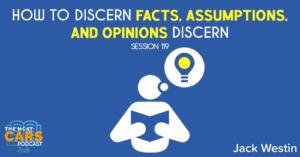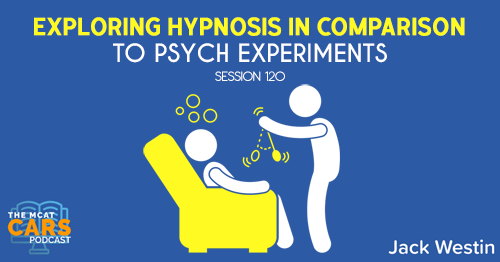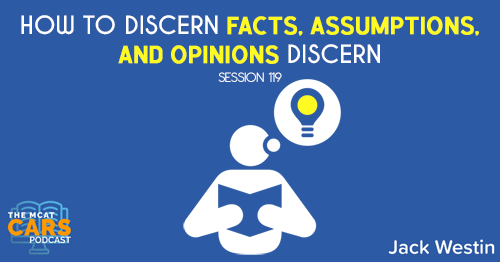Apple Podcasts | Google Podcasts
Session 119
Today, we talked about the difference between facts and opinions/assumptions that sounds factual. Understanding the differences can help you score high in CARS.
As always, I’m joined by Jack Westin from JackWestin.com. Check out all their amazing free resources including a free trial session of Jack’s full course to see how it’s like learning from Jack Westin himself.
Listen to this podcast episode with the player above, or keep reading for the highlights and takeaway points.
Link to the article:
Pterosaurs, such as pterodactyl, are some of the largest animals ever to have taken to the skies, but the first reptile aviators were clumsy flyers, only capable of traveling short distances, a study suggests. The research may also shed new light on the evolution of flight more generally.
Pterosaurs evolved around 245m years ago, and dominated the skies for more than 150m years, before dying out at the end of the Cretaceous period along with many of their dinosaur cousins. With long membranous wings stretching from the ankles to an elongated fourth finger, pterosaurs are considered the earliest vertebrates to have evolved powered flight. But what did these first flights look like?
Prof Chris Venditti, a lecturer in evolutionary biology at the University of Reading, and his colleagues estimated the wing size and body mass of various pterosaurs from their fossilised remains, and combined this with information about the metabolic rates of birds to calculate how much energy pterosaurs would have needed to fly, and how far they could have glided before dropping to the ground.
This revealed that, though airborne, the earliest pterosaurs are likely to have been ungainly aviators. “They would have been flying, but relatively clumsily. They may have been climbing up trees and flying from one trunk to another, but not flying very long distances and not very agile in their flight,” said Venditti, whose research was published in Nature.
Later pterosaurs were not only bigger, but their wings gradually became longer relative to their size, increasing their efficiency: “They would have been big and graceful flyers that soared through the air, maybe even migrating hundreds of kilometres,” Venditti said.
[02:01] General CARS Tips
History passages, especially, stump a lot of students because they look at a passage and assume it’s factual. But you have to be able to separate the facts from the opinions. And this is a good challenge because this passage provides you with opinions that may appear to be factual.
'You can argue facts – and that's a great lesson that can help you when you do history passages.'Click To Tweet[02:59] Paragraph 1, Sentence 1
Pterosaurs, such as pterodactyl, are some of the largest animals ever to have taken to the skies, but the first reptile aviators were clumsy flyers, only capable of traveling short distances, a study suggests.
Jack says:
The author is talking about pterodactyls and a study suggesting that they weren’t very good fliers. And based on how they write it, that’s what it seems like is happening. So some reptile aviators seem to be clumsy.
[03:59] Paragraph 1, Sentence 2
The research may also shed new light on the evolution of flight more generally.
Jack says:
Here’s a study looking at pterosaurs and this author is saying that we may learn how animals began to fly.
[04:22] Paragraph 2, Sentence 1
Pterosaurs evolved around 245m years ago, and dominated the skies for more than 150m years, before dying out at the end of the Cretaceous period along with many of their dinosaur cousins.
Jack says:
A little history lesson here about pterosaurs how long they lived and when they lived and when they died.
[04:59] Paragraph 2, Sentence 2
With long membranous wings stretching from the ankles to an elongated fourth finger, pterosaurs are considered the earliest vertebrates to have evolved powered flight.
Jack says:
Here’s another history lesson and anatomy lesson as well about their wings and the earliest vertebrates to fly.
[05:21] Paragraph 2, Sentence 3
But what did these first flights look like?
Jack says:
Notice the author is questioning the history of how they began to fly – the first fliers. Do we know what pterosaurs first flew like? Do we know how they flew? This was 245 million years ago, so they’re guessing. They’re not saying that directly, but they’re completely guessing.
And just like everything else – black holes or how the universe started, these are all guesswork, at least on a scientific scale. So be prepared to read something that seems historical, seems factual, but in reality, is completely based on opinion. It seems factual as a collective. Everyone just assumes that we see that in movies. And so we don’t really challenge that because we don’t think about pterodactyls.
[08:14] Paragraph 3, Sentence 1
Prof Chris Venditti, a lecturer in evolutionary biology at the University of Reading, and his colleagues estimated the wing size and body mass of various pterosaurs from their fossilised remains, and combined this with information about the metabolic rates of birds to calculate how much energy pterosaurs would have needed to fly, and how far they could have glided before dropping to the ground.
Jack says:
And the author used “glided.” And a lot of people think squirrels “fly” but they’re really just gliding. They also used the word calculated which sounds more sophisticated, like they’re actually measuring things the right way. Again, it’s all guesswork.
And why would the author not say they don’t know or they’re just guessing? That’s because the author wants to convince you of their opinion, by making it seem factual.
You have to realize that these are all opinions that they are trying to figure out facts. And by doing so, they try to make it look factual. So it’s hiding the fact that it’s an opinion and that is the problem for many students. That’s the problem for most of society and not being able to critically read things anymore.
“When you're force-fed information that completely goes against reality, your reality shifts, your interpretation of reality is totally different now.”Click To Tweet[10:22] Paragraph 4, Sentence 1
This revealed that, though airborne, the earliest pterosaurs are likely to have been ungainly aviators.
Jack says:
It’s probably suggesting that the first flights didn’t look very good.
[10:53] Paragraph 4, Sentence 2
“They would have been flying, but relatively clumsily.
Jack says:
That’s what “ungainly” probably means – clumsy.
[11:04] Paragraph 4, Sentence 3
They may have been climbing up trees and flying from one trunk to another, but not flying very long distances and not very agile in their flight,” said Venditti, whose research was published in Nature.
Jack says:
Again, we don’t know. But we’re guessing that they weren’t good fliers, at least when they started off.
[11:42] Paragraph 5, Sentence 1
Later pterosaurs were not only bigger, but their wings gradually became longer relative to their size, increasing their efficiency: “They would have been big and graceful flyers that soared through the air, maybe even migrating hundreds of kilometres,” Venditti said.
Jack says:
So they’re looking at the anatomy of different pterosaurs where they evolved and they had bigger wings, which would make the flight much easier for their bodies – still based on an opinion.
[13:42] Main Idea
This is another awesome article that breaks down trying to understand and challenging assumptions. It’s very similar to how the lay public gets very frustrated with food science. One day, salt is bad for you. The next day, salt is good for you. And that’s just science evolving in front of our eyes.
Especially with COVID-19, the public is very frustrated with science unfolding in front of our eyes. And the public thinks that scientists are a bunch of buffoons, but in reality like that science, you make assumptions. You have your hypothesis, you go test it, you come to a conclusion and go, that’s right or wrong. And if they couldn’t confirm that, they go back to the drawing board. And that’s science.
That’s why medicine values research so much because when you research stuff, you figure things out slowly and gradually, especially when you have other people from the field contributing their insights.
“A really big, important point to make about science is that it’s never exact.”Click To TweetAs you read science articles, it’s okay to see them as once an opinion. Have this mindset that things can change. It’s not to say that you should change your mind, but that you could potentially change your mind is important in science.
So definitely go with what people most people say, but have your own opinion about things and question things, and stay relevant to whatever is going on today. And don’t just stick to what we’ve learned in the past.
[18:09] Why Research is Important in Medicine
Research doesn’t necessarily have to be medical research. Are you comfortable challenging the status quo by continuing to ask questions, and continuing to use the scientific method to challenge things and learn things?
It’s so crazy for most students who just start medicine to realize that they can have an immediate impact if they study something more than everyone else in the field. And they do a research experiment that’s well organized. You could impact everyone’s opinion, or everyone’s judgment on your field.
Research is great for many reasons. It’s not just great for the fact that you’re contributing to society. But most importantly, it shows that you’re collaborative, it shows that you can work as a team as a unit to figure things out.
“The most important articles are published by many people, not just one.”Click To TweetUltimately, it takes a lot of effort to organize content and ideas and thoughts and express it in a way that anyone can understand. That being said, do research on something you’re interested in.
Links:
Link to the article:
SEARCH SITE
SEARCH SITE
LISTEN FOR FREE












